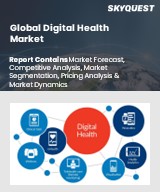
Report ID: SQSG35G2001

Report ID:
SQSG35G2001 |
Region:
Global |
Published Date: August, 2024
Pages:
165
|
Tables:
64 |
Figures:
75
Geographically, the digital health market is dominating in North America due to key factors like advanced healthcare infrastructure and high technology adoption. North America, especially the United States holds a well-established healthcare sector with advanced infrastructure and extensive use of EHRs and several other health techs. The region also has greater levels of innovation and technology adoption with heavy investments in digital health services comprising wearable devices, telehealth, and mobile health applications. These factors are driving the digital health market in the region. Moreover, the presence of most players like Allscripts, McKesson Corp, Cerner Corp, GE HealthCare, Epic Systems, AT&T, and others is impacting the market growth.
Asia-Pacific is projected to be the fastest-growing region among others due to the growing healthcare needs and speedy adoption of digitalization. Ever-increasing population, growing urbanization, and rising cases of chronic illnesses, ultimately demand improved healthcare services. Most nations in Asia-Pacific are witnessing speedy transformation that comprises adoption of digital health tools. This also includes explosive use of mobile health applications, smartphones, and wearable devices. These factors are expected to fuel the digital health market in the coming years.
Our industry expert will work with you to provide you with customized data in a short amount of time.
REQUEST FREE CUSTOMIZATIONDigital Health Market size was valued at USD 178 billion in 2022 and is poised to grow from USD 211 billion in 2023 to USD 881 billion by 2031, growing at a CAGR of 18.6% in the forecast period (2024-2031).
The digital health market players are using innovative strategies along with collaborations, mergers, and acquisitions deploying ways for enhancing the Healthcare Infrastructure and equipping it with future-ready digital advancements. Cloud computational technology and artificial intelligence (AI) are among the top used technologies among market players to generate high market share and have a competitive edge. 'Allscripts (US) ', 'McKesson Corporation (US) ', 'Apple Inc. (US) ', 'Alphabet Inc. (Google) (US) ', 'Microsoft Corporation (US) ', 'International Business Machines Corporation (IBM) (US) ', 'Athenahealth Inc. (US) ', 'Philips Healthcare (Netherlands) ', 'GE Healthcare (US) ', 'Siemens Healthcare (Germany) ', 'Qualcomm Life Inc. (US) ', 'Teladoc Health Inc. (US) ', 'Epic Systems Corporation (US) ', 'Johnson & Johnson (US) ', 'Agfa-Gevaert Group (Belgium) ', 'Infosys Limited (India) ', 'Wipro Limited (India) ', 'Tata Consultancy Services Limited (India) ', 'ECLINICALWORKS (US) ', 'MY MHEALTH LIMITED (UK)'
The adoption of smartphones, tablets, and PDAs has surged recently, becoming the primary source of internet connectivity in developed regions like North America and Europe. This trend is also rising in emerging areas due to affordable devices and expanding high-speed mobile networks. The widespread use of these mobile platforms significantly drives the digital health market, providing easy access to health apps, telemedicine, and wearable health tech. This technology enables proactive healthcare through remote consultations and real-time health monitoring.
Rising Demand Spurs Growth in mHealth Services: The surge in demand to enhance workflow efficiency across clinics, hospitals, and healthcare facilities propels the market for mHealth services. Additionally, continual technological advancements in developing advanced digital solutions, coupled with growing government and commercial initiatives, contribute to overall market expansion. For instance, scientists at the University of Illinois developed a camera to enhance smartphone diagnostic capabilities. In 2020, the mHealth technology sector dominated with the highest revenue share.
In 2023, North America led the market with a substantial revenue share of 38.2%, driven by technological advancements, increased healthcare IT spending to enhance infrastructure, favorable government initiatives, the rise of startups, and a readiness to embrace advanced technological solutions. Additional contributing factors include growing smartphone penetration, improved internet connectivity, and substantial funding opportunities. Furthermore, advancements in coverage networks, the rapid growth of smartphone adoption, an aging population, the prevalence of chronic diseases, and a shortage of primary caregivers also bolstered industry growth.
Want to customize this report? This report can be personalized according to your needs. Our analysts and industry experts will work directly with you to understand your requirements and provide you with customized data in a short amount of time. We offer $1000 worth of FREE customization at the time of purchase.

Report ID: SQSG35G2001